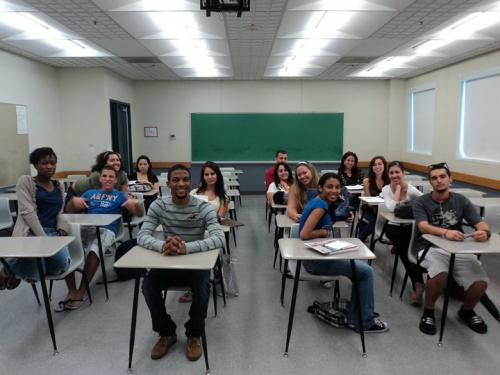
Image Credit:
Miami Classroom by Fredler Brave, from Wikipedia
Looking through the tags on Blogging Pedagogy earlier this semester, Rhiannon Goad’s lone post tagged “trans*” jumped out at me. In my experience, graduate students talk a lot amongst ourselves about uncomfortable, uncertain, or potentially hurtful situations we encounter in our classrooms, but we don’t often write about them or discuss them with our faculty mentors. If you’re like me, Rhiannon’s post may not have brought up memories of experiences with trans* students specifically, but it probably brought up at least one memory of a difficult to navigate situation involving a fraught topic like race, gender, or sexuality in our classrooms. Thinking back on my own teaching experiences, I wonder when we as instructors should intervene in these situations, and how we can keep our classrooms feeling as safe as possible for all of our students while also keeping our discussions open and honest.
I can think of one good example of a classroom incidents when I had to decide whether or not to intervene because of something that a student said during a discussion. While we were talking about a novel assigned in a British literature course, one of my students raised her hand and described a character using a string of offensive words. Half of the class turned to stare at her; the other half looked down at their books, squirming awkwardly. At first, I froze too. Should I call this student out on her offensive statement? Should I continue the discussion as if nothing happened? Should I start a discussion about the terminology that’s acceptable in this classroom? Finally, I asked her to "clarify" what she had said, and under the disapproving gaze of her classmates, she used different words. Later I wondered: Did I do enough to make the classroom feel safe for my other students? Should I have confronted this student about the repercussions of what she said? Should I have spoken to her in class or outside of class? Should I have followed up with some discussion about what we all heard?
When possible, I try not to intervene in classroom discussions, especially with older, more talkative students like the ones in my current rhetoric class. Teaching the Rhetoric of Tourism, race and gender are common topics of discussion; students deserve the space to resolve disagreements and fully discuss "awkward" topics amongst themselves. And obviously, all of our students cannot be completely comfortable with what is said in the classroom one hundred percent of the time. But what are some things we can do to make our classrooms feel safe(r), in Rhiannon’s words, for most of our students most of the time?
1. Model the language that we want to see used in our classrooms. This means discouraging the use of derogatory language as well as correcting incorrect language. This has been especially important in my Rhetoric of Tourism classroom, where my students often come across inflammatory and offensive texts and grapple with how to describe other people's often bigoted opinions.
2. Admit that there are problems with race, gender, and sexuality that merit discussion. My students are fond of referring to racism as something that “used to happen” or that was an issue “back in the day,” and they tend to avoid mention of sexuality at all costs. As instructors, we can interrogate the tendency to avoid these issues instead of letting them be swept under the rug, and use current examples to remind our students that discrimination is not a thing of the past.
3. Hold everyone accountable. We all want to avoid confrontation with our students, but that doesn’t mean we have to let them get away with insensitive comments. When a student says something offensive or makes a generalization, question them: “Why do you say that?” “What makes you think so?” or even simply, “Always?” “Everyone?” can be effective ways to coax students into reflecting on their beliefs and experiences.
4. This means holding yourself accountable, too. Was I projecting some of my own discomfort and fear of confrontation onto my students in the literature classroom? Undoubtedly. It’s just as important to keep a dialogue open with ourselves as with our students, about what our own conscious or subconscious prejudices are, what we feel particularly emotional about, and what makes us uncomfortable and why.
5. Work on your own demeanor. As we’ve all experienced, discussions about topics like race, gender, and sexuality can quickly change the atmosphere of a classroom from relaxed to incredibly fraught. We should do our best to project openness and trust, not anxiety. We can try to model the behavior we’d like to see your students exhibit towards each other.


Comments
This really spoke to me. #5
Comment:
This really spoke to me. #5 is tuff stuff for sure.